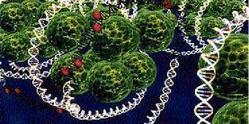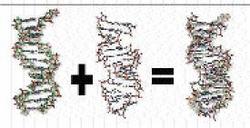
'You are what you eat' is a term long used by nutritionists to point out that a good diet is the basis of good health, but an emerging field in medicine may now extend this saying to include - 'and so will your children'.
We are all products of your genes - genetics is the study of how living organisms inherit features/traits from their ancestors, it tries to identify which features are inherited and work out the details of how these features are passed from generation to generation. For example, a child might inherit the trait to be tall, but if there is very little food where they live and they are poorly nourished, they will still be short. Genetic information is carried by a long molecule called deoxyribonucleic acid DNA which is copied and inherited across generations. Traits are carried in DNA as instructions for constructing and operating an organism, and these instructions are contained in segments of DNA called genes.
Decoding the Code
Gene expression is the process by which heritable information from a gene, such as the DNA sequence, is made into a functional gene product, such as protein or RNA. It is this process of translation and transcription that in the end determines protein levels in our body that can define our physical appearance, for example, a person's eye-colour, height or weight, and many other types of traits that range from aspects of behavior to resistance to disease.
The process of expressing the information stored in DNA as different protein levels
upload.wikimedia.org/wikipedia/commons/3/37/Genetic_code.svg
The Software to the Hardware
The Greek prefix epi in epigenetics implies features that are 'on top of' or 'in addition to' genetics; thus epigenetic traits exist on top of or in addition to the traditional molecular basis of inheritance. Epigenetics is the study of the changes in the gene expression caused by mechanisms other then changes in the underlying DNA sequence. These changes may remain through cell divisions for the remainder of the cell's life and may also last for multiple generations. What researchers have found is that an addition of a certain group of chemicals called the methyl group to what is now called the epigenome, can effectively turn on or off certain gene expressions, this process is called DNA Methylation. The methyl group of is a group hydrocarbons that is named after methane (CH4) from which it is derived by the removal of a hydrogen atom to form CH3 .
The main theory states that certain foods which contain chemicals that are considered methyl donors can in effect counter the inhibitors of gene expression to essentially turn off the negative gene suppression. The vitamin B complex and folic acid are known members of this methyl-donors group, and some research has shown a soy-rich diet that supplies regular does of both of these substances in mice just before conception can inhibit the transmission certain genes responsible for diabetes and obesity, to the offspring. The recently concluded Human Genome Project identified about 25 thousand individual genes, and now a similar project is underway to map the Epigenome, in hopes of finding methylation sites and unlocking the correlation between external non-genetic factors, such as environmental exposures and dietary intake to gene expression.
DNA methylation of attaching methyl donors that acts as inhibitors to sequences of the epigenome and effectively turns of the gene expression
www.pbs.org/wgbh/nova/sciencenow/3411/02-tale-flash.html
While it is still in the early phases, this principle is being explored in the treatment of various diseases such as cancer and diabetes. It is also being used in the study of embryonic development, in investigating the passing of hereditary diseases to offspring. Professor Terrence Forrester and Dr Michael Boyne published a paper entitled 'Nutrition in pregnancy and the risk of chronic non-communicable diseases in offspring', which highlights this research area.
Cancer treatments are now being tailored to search not only for mutated genes but also epigenomes that can affect the expression of the gene permanently that can also be passed on to offspring. In cancer cells, genes are either modified by mutations, which alter the function of the proteins they encode, or through epigenetics - modifications to chromosomes that alter gene-expression patterns. Because the research is still in the early stages, little is known about how these chemical modifications occur in the DNA of cancer cells, but they can affect the expression patterns of oncogenes or of tumour suppressor genes. For example, 'epigenetic silencing' induced by DNA methylation or the loss of expression of tumour suppressor genes, causes normal cells to be transformed into cancer cells. The theory is if we can block this silencing then we can in effect turn the growth suppressor genes back on, to inhibit cancer growth.
This is an exciting new field in medicine that can unlock limitless potential for cures for diseases and more targeted treatments. It also is an awakener that everything we do, eat, and are exposed to, not only affect us in this lifetime, but can also affect the health of future generations.
- V.H.


DNA RNA DNA and RNA
The DNA and its surface component the RNA

